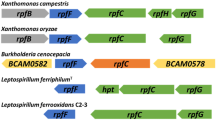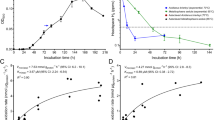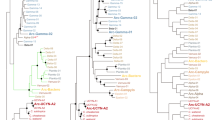Abstract
Biofilms can provide a number of different ecological niches for microorganisms. Here, a multispecies biofilm was studied in which pyrite-oxidizing microbes are the primary producers. Its stability allowed not only detailed fluorescence in situ hybridization (FISH)-based characterization of the microbial population in different areas of the biofilm but also to integrate these results with oxygen and pH microsensor measurements conducted before. The O2 concentration declined rapidly from the outside to the inside of the biofilm. Hence, part of the population lives under microoxic or anoxic conditions. Leptospirillum ferrooxidans strains dominate the microbial population but are only located in the oxic periphery of the snottite structure. Interestingly, archaea were identified only in the anoxic parts of the biofilm. The archaeal community consists mainly of so far uncultured Thermoplasmatales as well as novel ARMAN (Archaeal Richmond Mine Acidophilic Nanoorganism) species. Inductively coupled plasma analysis and X-ray absorption near edge structure spectra provide further insight in the biofilm characteristics but revealed no other major factors than oxygen affecting the distribution of bacteria and archaea. In addition to catalyzed reporter deposition FISH and oxygen microsensor measurements, microautoradiographic FISH was used to identify areas in which active CO2 fixation takes place. Leptospirilla as well as acidithiobacilli were identified as primary producers. Fixation of gaseous CO2 seems to proceed only in the outer rim of the snottite. Archaea inhabiting the snottite core do not seem to contribute to the primary production. This work gives insight in the ecological niches of acidophilic microorganisms and their role in a consortium. The data provided the basis for the enrichment of uncultured archaea.
Similar content being viewed by others
Log in or create a free account to read this content
Gain free access to this article, as well as selected content from this journal and more on nature.com
or
References
Amaral-Zettler LA, Zettler ER, Theroux SM, Palacios C, Aguilera A, Amils R . (2011). Microbial community structure across the tree of life in the extreme Rio Tinto. ISME J 5: 42–50.
Baker BJ, Comolli LR, Dick GJ, Hauser LJ, Hyatt D, Dill BD et al (2010). Enigmatic, ultrasmall, uncultivated Archaea. Proc Natl Acad Sci USA 107: 8806–8811.
Baker BJ, Tyson GW, Webb RI, Flanagan J, Hugenholtz P, Allen EE et al (2006). Lineages of acidophilic archaea revealed by community genomic analysis. Science 314: 1933–1935.
Balashova VV, Vedenina IY, Markosyan GE, Zavarzin GA . (1973). The auxotrophic growth of Leptospirillum ferrooxidans. Mikrobiologiya 43: 581–585.
Bond PL, Druschel GK, Banfield JF . (2000). Comparison of acid mine drainage microbial communities in physically and geochemically distinct ecosystems. Appl Environ Microbiol 66: 4962–4971.
Brioukhanov AL, Netrusov AI . (2004). Catalase and superoxide dismutase: distribution, properties, and physiological role in cells of strict anaerobes. Biochemistry 69: 949–962.
Brown JF, Jones DS, Mills DB, Macalady JL, Burgos WD . (2011). Application of a depositional facies model to an acid mine drainage site. Appl Environ Microbiol 77: 545–554.
Clark WM . (1960) Oxidation-Reduction Potentials of Organic Systems. Waverly Press: Baltimore, MD, USA.
Cole JR, Wang Q, Cardenas E, Fish J, Chai B, Farris RJ et al (2009). The Ribosomal Database Project: improved alignments and new tools for rRNA analysis. Nucleic Acids Res 37: D141–D145.
Dopson M, Baker-Austin C, Hind A, Bowman JP, Bond PL . (2004). Characterization of Ferroplasma isolates and Ferroplasma acidarmanus sp. nov., extreme acidophiles from acid mine drainage and industrial bioleaching environments. Appl Environ Microb 70: 2079–2088.
Elias DA, Krumholz LR, Tanner RS, Sulfita JM . (1999). Estimation of methanogen biomass by quantitation of coenzyme M. Appl Environ Micobiol 65: 5541–5545.
Gale NL, Beck JV . (1967). Evidence for the calvin cycle and hexose monophosphate pathway in Thiobacillus ferrooxidans. J Bacteriol 94: 1052–1059.
García-Moyano A, González-Toril E, Aguilera A, Amils R . (2007). Prokaryotic community composition and ecology of floating macroscopic filaments from an extreme acidic environment, Río Tinto (SW, Spain). Syst Appl Microbiol 30: 601–614.
Golyshina OV, Pivovarova TA, Karavaiko GI, Kondrateva TF, Moore ER, Abraham WR et al (2000). Ferroplasma acidiphilum gen. nov., sp. nov., an acidophilic, autotrophic, ferrous-iron-oxidizing, cell-wall-lacking, mesophilic member of the Ferroplasmaceae fam. nov., comprising a distinct lineage of the Archaea. Int J Syst Evol Microbiol 50 ((Pt 3):): 997–1006.
Gonzalez-Toril E, Aguilera A, Souza-Egipsy V, Lopez Pamo E, Sanchez Espana J, Amils R . (2011). Geomicrobiology of La Zarza-Perrunal acid mine effluent (Iberian Pyritic Belt, Spain). Appl Environ Microbiol 77: 2685–2694.
Hallberg KB . (2010). New perspectives in acid mine drainage microbiology. Hydrometallurgy 104: 448–453.
Hallberg KB, Coupland K, Kimura S, Johnson DB . (2006). Macroscopic streamer growths in acidic, metal-rich mine waters in north wales consist of novel and remarkably simple bacterial communities. Appl Environ Microbiol 72: 2022–2030.
Hippe H . (2000). Leptospirillum gen. nov. (ex Markosyan 1972), nom. rev., including Leptospirillum ferrooxidans sp. nov. (ex Markosyan 1972), nom. rev. and Leptospirillum thermoferrooxidans sp. nov. (Golovacheva et al. 1992). Int J Syst Evol Microbiol 50 ((Pt 2):): 501–503.
Huber R, Stetter KO . (2001). Thermoplasmatales. In: The Prokaryotes: An Evolving Electronic Resource for the Microbiological Community: Dworkin M, Falkow S, Rosenberg E, Schleifer K-H, Stackebrandt E, (eds) Springer: New York, NY, USA.
Johnson DB, Hallberg KB . (2005). Acid mine drainage remediation options: a review. Sci Total Environ 338: 3–14.
Johnson DB, McGinness S . (1991). Ferric iron reduction by acidophilic heterotrophic bacteria. Appl Environ Microbiol 57: 207–211.
Jones D, Brown J, Larson L, Mills D, Burgos W, Macalady J . (2011). Ecological niches of Fe-oxidizing acidophiles in a coal mine discharge. In Goldschmidt Abstracts 2011. Mineral Mag 75: 1092–1131.
Kimura S, Bryan CG, Hallberg KB, Johnson DB . (2011). Biodiversity and geochemistry of an extremely acidic, low-temperature subterranean environment sustained by chemolithotrophy. Environ Microbiol 13: 2092–2104.
Kolmert A, Wikstrom P, Hallberg KB . (2000). A fast and simple turbidimetric method for the determination of sulfate in sulfate-reducing bacterial cultures. J Microbiol Methods 41: 179–184.
Kriews M, Dunker E, Reinhardt H, Beninga I, Hoffmann E, Lüdtke C . (2001) Patentschrift DE000019934561C2.
Kriews M, Reinhardt H, Dunker E, Beninga I, Ruhe W . (2004) Utility Patent DE 20 2004 005 9916.
Lo I, Denef VJ, VerBerkmoes NC, Shah MB, Goltsman D, DiBartolo G et al (2007). Strain-resolved community proteomics reveals recombining genomes of acidophilic bacteria. Nature 446: 537–541.
Maciag WJ, Lundgren DG . (1964). Carbon dioxide fixation in the chemoautotroph, Ferrobacillus ferrooxidans. Biochem Biophys Res Commun 17: 603–607.
Maklashina E, Berthold DA, Cecchini G . (1998). Anaerobic expression of Escherichia coli succinate dehydrogenase: functional replacement of fumarate reductase in the respiratory chain during anaerobic growth. J Bacteriol 180: 5989–5996.
Nordstrom DK . (2000). Advances in the hydrogeochemistry and microbiology of Acid Mine Waters. Int Geol Rev 42: 499–515.
Okabe S, Kindaichi T, Ito T . (2004). MAR-FISH - An ecophisiological approach to link phylogenetic affiliation and in situ metabolic activity of microorganisms at a single-cell resolution. Microb Environ 19: 83–98.
Pernthaler A, Pernthaler J, Amann R . (2004). Sensitive multi-color fluorescence in situ hybridisation for the identification of environmental microorganisms. Mol Microb Ecol Man Second Ed 3: 711–726.
Pronk JT, Johnson DB . (1992). Oxidation and reduction of iron by acidophilic Bacteria. Geomicrobiol J 10: 153–171.
Reinhardt H, Kriews M, Miller H, Schrems O, Ludke C, Hoffmann E et al (2001). Laser ablation inductively coupled plasma mass spectrometry: a new tool for trace element analysis in ice cores. Fresenius J Anal Chem 370: 629–636.
Rogers AW . (1979) Techniques of Autoradiography. Elsevier: New York, NY, USA.
Rowe OF, Sanchez-Espana J, Hallberg KB, Johnson DB . (2007). Microbial communities and geochemical dynamics in an extremely acidic, metal-rich stream at an abandoned sulfide mine (Huelva, Spain) underpinned by two functional primary production systems. Environ Microbiol 9: 1761–1771.
Singer PC, Stumm W . (1970). Acidic mine drainage: the rate-determining step. Science 167: 1121–1123.
Steedman HF . (1957). Polyester wax; a new ribboning embedding medium for histology. Nature 179: 1345.
Stookey LL . (1970). Ferrozine—a new spectrophotometric reagent for iron. Anal Chem 42: 779–781.
White RH, Zhou D . (1993). Biosynthesis of conenzymes in methanogens. In: Methanogenesis GJ, Ferry (ed) Chapman and Hall: New York, NY, USA.
Zakrzewski M, Bekel T, Ander C, Pühler A, Rupp O, Stoye J et al (2012). MetaSAMS—A novel software platform for taxonomic classification, functional annotation and comparative analysis of metagenome datasets. J Biotechnol e-pub ahead of print 29 September 2012; doi: 10.1016/j.jbiotec.2012.09.013.
Ziegler S, Ackermann S, Majzlan J, Gescher J . (2009). Matrix composition and community structure analysis of a novel bacterial pyrite leaching community. Environ Microbiol 11: 2329–2338.
Zielinski FU, Pernthaler A, Duperron S, Raggi L, Giere O, Borowski C et al (2009). Widespread occurrence of an intranuclear bacterial parasite in vent and seep bathymodiolin mussels. Environ Microbiol 11: 1150–1167.
Acknowledgements
We thank Professor Georg Fuchs for all the assistance, Professor Peter Graumann and Felix Dempwolff for access to the fluorescence microscopes. We gratefully acknowledge Dr Nicole Dubilier and Silke Wetzel from the MPI Bremen for sharing their FISH knowledge with us. Thanks to Dr Horst Scheffler and Gerd-Otto Herrmann from the pyrite mine ‘Drei Kronen und Ehrt’. Thanks to Dr Andrea Wieland for assistance with the oxygen electrode. Thanks to A Voegelin for providing the Fe(II)sulfate spectrum, to Ralph Steininger (ANKA) for helpful discussions about PCA analysis and for beamtime at ANKA. Thanks to Florian Mann for help with the Metagenome data. SZ greatly appreciates the scholarship of the State Law on Graduate Funding Baden-Württemberg. This work was funded by the DFG, Grant no. GE2085/4-1.
Author information
Authors and Affiliations
Corresponding author
Additional information
Supplementary Information accompanies this paper on The ISME Journal website
Supplementary information
Rights and permissions
About this article
Cite this article
Ziegler, S., Dolch, K., Geiger, K. et al. Oxygen-dependent niche formation of a pyrite-dependent acidophilic consortium built by archaea and bacteria. ISME J 7, 1725–1737 (2013). https://doi.org/10.1038/ismej.2013.64
Received:
Revised:
Accepted:
Published:
Issue date:
DOI: https://doi.org/10.1038/ismej.2013.64
Keywords
This article is cited by
-
Microbial diversity in extreme environments
Nature Reviews Microbiology (2022)
-
Prokaryotic communities in the historic silver mine Reiche Zeche
Extremophiles (2022)
-
Acid Mine Drainage as Habitats for Distinct Microbiomes: Current Knowledge in the Era of Molecular and Omic Technologies
Current Microbiology (2020)
-
Microbial megacities fueled by methane oxidation in a mineral spring cave
The ISME Journal (2018)
-
Metabolic versatility of small archaea Micrarchaeota and Parvarchaeota
The ISME Journal (2018)



